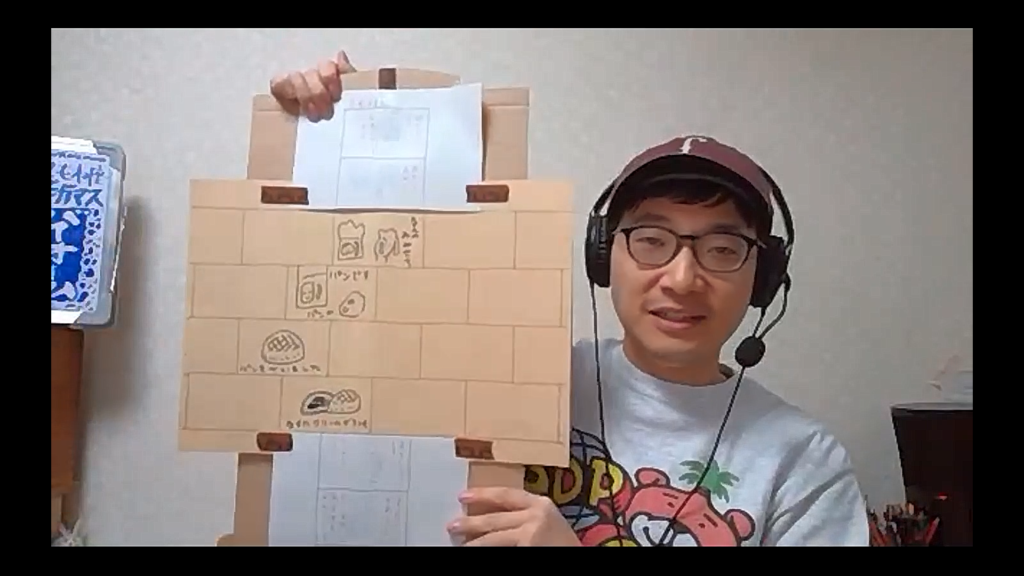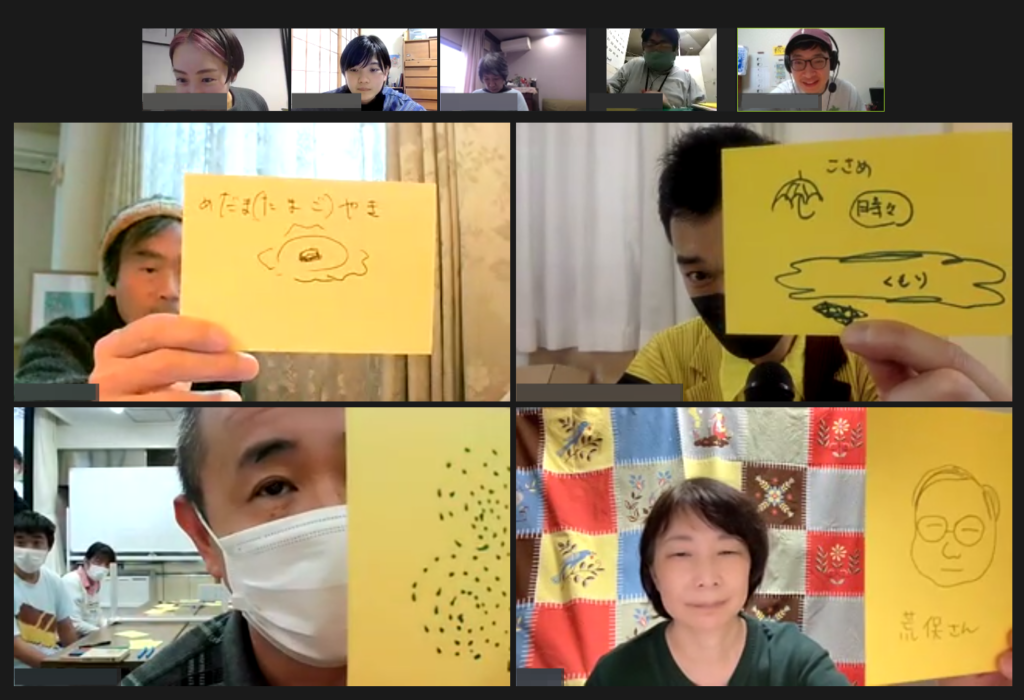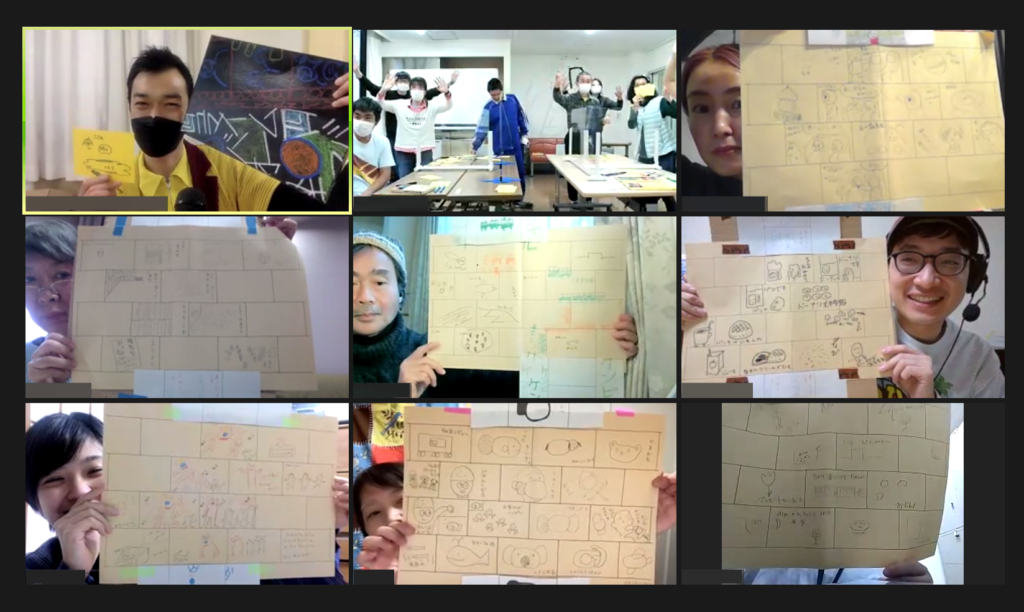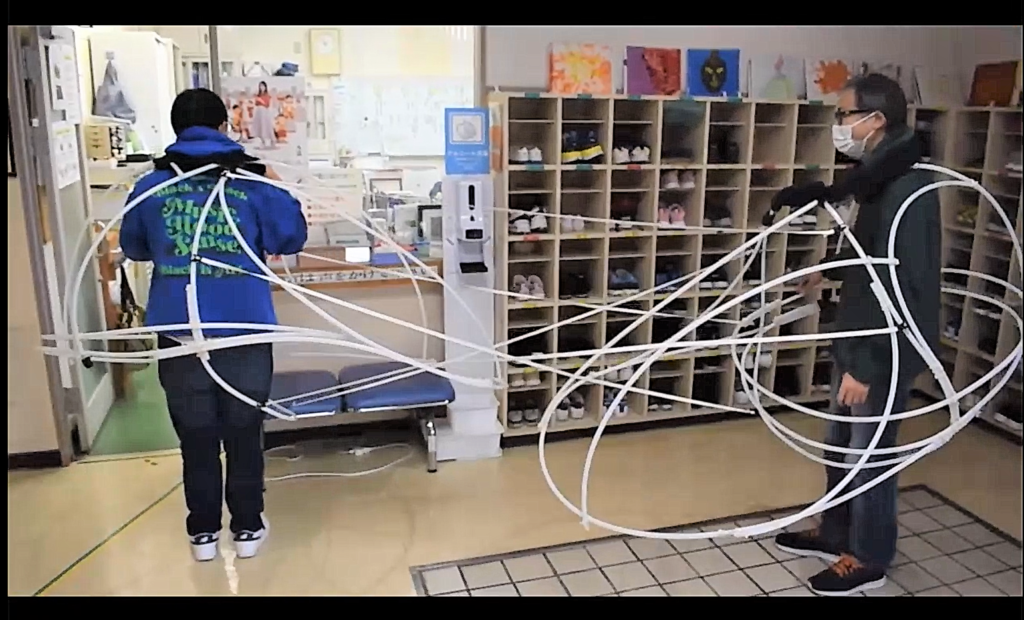diary
Itabashi-ku Komone Fukushien (welfare facility) “Yonkoma Manga Correspondence Theater: Komone-za ‘Lightning! Giga-Mass Biome’” Report
2022.1.14
TURN Project Management StaffItabashi-ku Komone Fukushien (welfare facility) runs TURN LAND in collaboration with artists Kentaro Onishi and Atsushi Miyata.
On Wednesday, December 8th, “Yonkoma Manga* Correspondence Theater: Komone-za ‘Lightning! Giga-Mass Biome’” was held online. In this report we give a snapshot from the day, of an event which built on the concept of “Remote Correspondence Theater: Komone-za ‘Yonkoma Biome’” held previously in January 2021, featuring an enthusiastic exchange of energy between members of the Komone-za project (comprising of members (users) from Komone Fukushien welfare facility), and outside participants.
*Yonkoma Manga: a 4 frame comic strip format used in Japan
■ Wanting to convey the energy of Komone Fukushien members
The “Gigamass Biome” event began with a few opening words by Noriko Takada, Komone-za leader and Komone Fukushien staff member, who said she wanted to “convey the energy that Komone Fukushien members have” through the event. First, Miyata and Komone-za members gave guest participants details of the event, which would utilize a mechanism used in his interactive bookmaking and story building concept, “Bibuncho**.”
“Bibuncho” involves first folding a piece of paper in half to give four sides (pages) of paper, one participant writing a story on the four sides, and another then inserting their own four-sided story between the first piece of paper. This way, when one person has written on the first four sides and a separate piece of paper with four more sides has been inserted between the first piece of paper with new sentences added by another person, a connected story is created.
** Learn more about “Bibuncho” here
The “Giga-Mass Biome” event also employed this mechanism, with the guest participants adding new drawings to the Yonkoma (four-frame) manga drawn by Komone-za members.
The previous “Yonkoma Biome” event involved adding four manga frames between the original four frames (written by Komone-za members), but this time around the connected story was further developed through the use of a “Biome sheet.”
A “Biome sheet” is a sheet of paper with manga frames stacked in a brick-like configuration, giving participants a free hand to develop a story by adding material diagonally, or taking the story in two different directions, and so on.

Each guest participant developed a new story; for example, depicting the lines of the frames as train tracks or adding characters associated with the different station stops to the four frames, which were drawn like the moving landscape during a journey.
■ “Let’s see your Kakeai (cross talk) cards!”
After presenting two Biome sheets drawn by participants, the event proceeded to the next activity. Onishi produced a yellow business-card-sized “Kakeai (crosstalk) card.” In the “Kakeai (crosstalk) card” activity, an outside participant would show their Biome sheet on screen, Komone-za members would then write/draw on their cards whatever came to mind, such as an association, or something linked to a memory, etc.hen they would hold their cards up to the screen, thereby elaborating on the original concept and vision of the participant presenting their Biome sheet story.
Onishi would shout, “Let’s see your Kakeai (crosstalk) cards!,” and Komone-za members would take turns showing their cards.

A succession of cards appeared onscreen, enlarging upon the outside participants’ visions: cards with unique words and text written on them; cards featuring lots of faces; cards with drawings of hamburger steak bento boxes, and so on. Komone-za members enthusiastically held their cards up to the screen, with some of them showing more than one card.
Their enthusiasm caught on, with guest participants drawing additional Biome sheets in response, one after the other.

During the intermission for this event, a video was shown of a new Komone-za project that members worked on this year called “Colleda Radar.”
“Colleda Radar” involves several people spending time clad in a “wearable device.” By two costumes connecting to form one, each person’s movement affects the other’s, resulting in it being unclear which person is making the movement to begin with.
The video showed how people’s movements synchronized, so you couldn’t tell whose movement it was (“Colleda Radar” being a play on the Japanese “kore, dare da” or “who is that ?”).

After this, the outside participants also proactively produced Kakeai (cross talk) cards, with screens switching one after another to spotlight the different cards. The cross talk (“kakeai”) that resulted from the use of participants’ Biome sheets was a great success. The activity finished with everyone showing each other their Biome sheets. The sheets looked completely different from how they were drawn at the beginning, with some people’s sheets filled to the rim!
At the end of the session, Komone-za leader Takada offered a few closing words.
Takada: So what did you all think of the energy and spirit of the Komone-za members? For twenty years I’ve been doing this job, captivated by the charm of the people who use this facility. Another time I hope to meet all of you (the participants) face-to-face, and I also hope you will join and get involved with us again in future.
This Komone-za event proved to be a trial and error exercise in how to convey the energy and spirit of Komone Fukushien members (facility users) through the medium of the internet. The stage is set for further evolution where one can anticipate new developments from the Komone-za project going forward.
関連記事